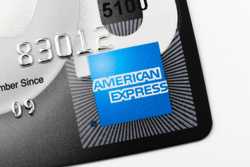What’s Considered a Good APR for Credit Cards?

Our evaluations and opinions are not influenced by our advertising relationships, but we may earn a commission from our partners’ links. This content is created by TIME Stamped, under TIME’s direction and produced in accordance with TIME’s editorial guidelines and overseen by TIME’s editorial staff. Learn more about it.
You’ve probably heard the term “APR” thrown around a lot in the world of credit. Put simply, this is the interest rate you’re subject to when you do things like:
APR, which stands for annual percentage rate, is often extremely high. Even a low APR can really hurt your finances if you find yourself in debt.
So, what is a good APR for a credit card? Few of the most popular credit cards offer an interest rate below 16%. More commonly, you’ll pay around 20% in interest, even if you’ve got an excellent credit score and especially if you’re applying for any of the best rewards credit cards.
Let’s examine credit card APR and learn how to avoid paying it.
As we’ll cover in a minute, credit card APR is determined by many things including your credit score and the specific credit card you’re opening. With that in mind, here are some of the best credit cards to consider depending on your credit score.
As you can see, these cards have some of the lower base APR rates. But they can also charge quite high rates, depending on how trustworthy the card issuer considers you.
Several factors account for the exact interest rate you are offered when opening a credit card. Some are based on your credit profile, others involve external factors over which you have no control. Because of this, you won’t know your exact rate until you’ve actually opened the card.
Here’s what the bank takes into account before it decides your interest rate:
It’s also worth noting that the APR you’ll be charged depends on the transaction you’ve performed. For example, a balance that you carry month-to-month may have lower interest rates than a cash advance APR, a balance transfer APR, or any penalty APR you may incur from a late payment.
It’s critical to mention that your decision to open a credit card should not be based on the card’s APR. If you think you’ll rack up interest by regularly not paying your balances in full each month, limit your use of these cards. Any rewards you may earn from everyday spending will almost certainly be negated by the interest you’ll pay. If you’re not careful, you can find yourself in a debt hole that is very difficult to escape—all because of interest charges.
That said, it’s easy to compare interest rates. APR ranges are often printed conspicuously on a credit card’s application page, saving you the trouble of digging into the pricing and terms of each card to find your answer.
If you’re browsing credit cards all issued by the same bank, you may find a “card comparison” tool that allows you to view the highlights of each card side-by-side. If you’re comparing cards across banks, the process will be slightly more tedious, but still quite easy. Again, remember to look at more than just the purchase APR. Make sure to also examine balance transfer, cash advance, penalty, and intro APR.
Credit cards that charge a high APR are often rewards credit cards, such as those cobranded by airlines and hotels or any credit cards that earn transferable bank points such as Chase Ultimate Rewards®, American Express Membership Rewards®, and Capital One miles. These cards tend to be higher risk but higher reward. For example, you may receive well over $1,000 in value from a high-APR credit card’s welcome bonus, but be subject to an interest rate around 29% if you carry a balance each month.
These interest rates may sound scary, but remember: If you pay your bill on time, and in full, these numbers won’t affect you in the slightest.
Alternatively, credit cards designed for those with poor credit may have equally high APRs simply because the applicant hasn’t sufficiently demonstrated healthy credit habits. Banks consider them a risk.
Even credit cards with “low” APRs still charge crippling ongoing interest rates. After all, any money you’re spending on fees is effectively feeding your income through the paper shredder.
Cards offering relatively low interest are commonly those that don’t charge an annual fee and collect rewards such as cash back. They sometimes even provide a 0% intro APR window for purchases and/or balance transfers.
Low-APR credit cards tend not to be the fanciest or confer the most valuable benefits. But the comfort of a low interest rate may be more useful to you. How to qualify for a good credit card APR
As mentioned above, your credit score is a massive factor in deciding the APR you receive when opening a credit card. The bank must trust you if they are to extend a line of credit to you at a favorable interest rate. The best tool they have to calculate your trustworthiness is your credit score.
In other words, you’ll need a lengthy history of on-time payments. You’ll also need to exhibit a low credit utilization. Rule of thumb says that you shouldn’t use more than 30% of your available credit.
Some credit cards (often those for beginners) come with a built-in feature that lowers your APR over time based on good habits.
For example, the annual_fees annual fee card_name will automatically consider you for a 2% APR reduction each account anniversary. All you have to do is spend at least $1,000 on purchases each cardmember year and make all your payments on time. You’re eligible to reduce your interest all the way down to the current prime rate plus 9.74%. That’s impressively low.
For other cards that don’t offer this benefit, you are free to request a lower interest rate by calling the credit card issuer directly. You can use your good habits, such as reliable payment history and low credit utilization, to plead your case. It’s not a guarantee that the bank will capitulate, but it’s certainly worth a try.
It’s worth repeating ad nauseam: You will avoid paying APR if you pay your statement balance on-time and in full each month. This simple action means interest rates have no power over you.
If you’re diligent with your budgeting and treat your credit cards like debit cards (that is, you pay your bill soon after you make a purchase), you’ll do well in the world of credit. Then you can focus on rewards, not APR, in choosing credit cards.
Also, you can look into credit cards that offer a window of 0% intro APR after account opening. Some of the best credit cards offer between 15 and 21 interest-free months on purchases and balance transfers. They can come in handy if you’re expecting a large purchase that you don’t think you’ll be able to pay off for a while.
Credit card APR is often between 16% and 29%. That’s a wide margin dictated by several things, including:
Obviously, the lower the APR, the less you’ll pay in the event that you rack up fees due to hanging balances, late payments, balance transfers, etc. But if you’re responsible with your money and don’t experience a run of bad luck, you should rarely encounter an interest payment.
APR stands for “annual percentage rate.” Credit card APR is simply the interest rate you’ll pay for certain actions you take with your card, such as making a purchase or taking out a cash advance. It’s figured on a yearly basis, even if the interest you accrue is (likely) compounded daily.
There are four different types of APRs:
The information presented here is created by TIME Stamped and overseen by TIME editorial staff. To learn more, see our About Us page.



